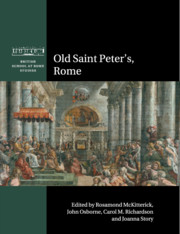Crossref Citations
This Book has been
cited by the following publications. This list is generated based on data provided by Crossref.
2015.
Books Received.
The Journal of Ecclesiastical History,
Vol. 66,
Issue. 2,
p.
461.
Sheckler, Allyson Everingham
and
Leith, Mary Joan Winn
2016.
The Santa Sabina Acclamation Panel Once Again: Reading from the Inside Out.
Source: Notes in the History of Art,
Vol. 35,
Issue. 4,
p.
272.
Baker‐Bates, Piers
2016.
Rome, sacred city.
Renaissance Studies,
Vol. 30,
Issue. 3,
p.
469.
Darby, Peter
2017.
The Codex Amiatinus Maiestas Domini and the Gospel Prefaces of Jerome.
Speculum,
Vol. 92,
Issue. 2,
p.
343.
McKitterick, Rosamond
2019.
East and West in the Early Middle Ages.
p.
165.
Smith, Christine
O'Connor, Joseph F.
and
Vegio, Maffeo
2019.
Eyewitness to Old St Peter's Basilica.
Grafton, Anthony
2020.
The 2019 Josephine Waters Bennett Lecture: The Winged Eye at Work: Leon Battista Alberti Surveys Old St. Peter's.
Renaissance Quarterly,
Vol. 73,
Issue. 4,
p.
1137.
McKitterick, Rosamond
2020.
Rome and the Invention of the Papacy.
Arnaud, Pascal
and
Keay, Simon
2020.
Roman Port Societies.
Bosman, L.
Haynes, I. P.
and
Liverani, P.
2020.
The Basilica of Saint John Lateran to 1600.
Dey, Hendrik
2021.
The Making of Medieval Rome.
Tambling, Jeremy
2021.
The Poetry of Dante's Paradiso.
p.
193.
Percec, Virgil
Adamson, Jasper
and
Gianti, Eleonora
2023.
Supramolecular Nanotechnology.
p.
1.





